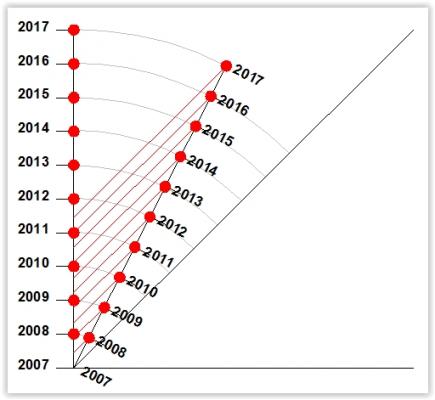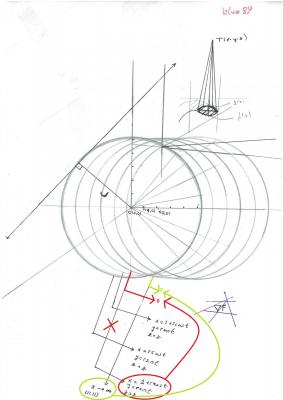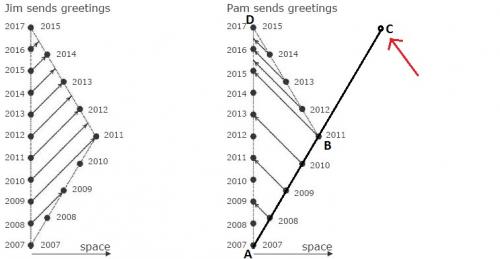-
Posts
6258 -
Joined
-
Last visited
-
Days Won
2
Content Type
Profiles
Forums
Events
Everything posted by michel123456
-

Relativity and shared realities (split from clocks, rulers...)
michel123456 replied to michel123456's topic in Relativity
------------------ Here you are: In this diagram, there is no time dilation as per Einstein. There is only a rotation. And the result is also that the traveller observes the time on Earth clicking slowly: when the time on the rocket is 2017, the time on Earth is only June of 2011. And this diagram is fully reversible. It is symmetric, one can flip flop the Earth & the rocket without any contradiction. So that seems to be my error: your simultanity lines are not at 45 degrees, parallel to SOL. Why? And what gives you the angle? -

Relativity and shared realities (split from clocks, rulers...)
michel123456 replied to michel123456's topic in Relativity
OK one by one in red fonts inside your comments below -

Relativity and shared realities (split from clocks, rulers...)
michel123456 replied to michel123456's topic in Relativity
The right diagram makes perfect sense. No problem here. The left diagram makes no sense at all. 1.Why are the red lines reversed in the upper part?(it looks to me as if past & future were reversed and that makes no sense to me but obviously I must miss something) -edit- the observer gets information from the past (the lower part of the diagram) no matter its direction of motion. 2. Why are 2 red lines in the middle not exactly at 45 degrees (as if SOL was not =c) 3. What is the gap between below 3.2years and up 3.2 years? (does the rocket "miss" something of earth history while making the turnaround?) ------------------- (edited)- twice. -

Relativity and shared realities (split from clocks, rulers...)
michel123456 replied to michel123456's topic in Relativity
Yes I missed that and I still do. The observed object has the same length in both cases (but I must miss something) I have understood that a clock doesn't tick "so faster than I thought it was", i.e. that the clock that clicked slower only regains its original clicking rate (maybe wrong wording here). As for the rest I don't understand where I am misunderstanding spacetime diagrams. -

Relativity and shared realities (split from clocks, rulers...)
michel123456 replied to michel123456's topic in Relativity
Concerning the bold black text above: The ruler can expand? More than what is measured at rest in its own frame? Concerning the blue text : many many reasons (like you said the laws of optics) make us observe the world with paramorphosis. Relativity is another effect. About clocks, there is nothing weird into observing a clock retarding on others. The weird thing happens when the clocks are reunified because the symmetry of Relativity is broken: it should have been that both clocks see the other as ticking slower. While in the famous twin paradox, there is no such a symmetry. There is a "preferred" clock at rest and an "unpreferred" clock in motion. This second clock observes exactly the contrary of what Relativity tells us. -

Relativity and shared realities (split from clocks, rulers...)
michel123456 replied to michel123456's topic in Relativity
Because this thread is going away from the OP, I would like to resume the question. From what I understand, everybody except me agree that all observers are correct when observing that the ruler/ship/train is contracting. My objection to that is NOT that they are actually observing that phenomenon. My objection is that it is not possible for the ruler/ship/train to be physically large/short/shorter all at the same time. To me, there must be only one single physical entity. This "physical entity" is the one that you draw in the diagram. It is the ruler/ship/train as measured at rest in its own frame. Because if you have no starting point, no proper length, then the ruler/ship/train has multiple lengths and it is impossible to draw it in your diagram at the first place. ----------------- And to add: this proper length never changes. The effect of shortening is an effect caused by observation from another state of motion. Again, the observer can have no effect on the physical entity. And, what a coincidence, it appears that this length is the maximum possible from all other states of motion! It is a "special" length. -

What are you listening to right now?
michel123456 replied to heathenwilliamduke's topic in The Lounge
From Greek artist Papercut. -

May we use our hand writing/drawing as a figure in our paper?
michel123456 replied to blue89's topic in Engineering
Also you must care about ease of understanding and avoid crossing labels. See below As your label (the equation) increase, the position must follow and avoid crossing lines. Here the progression is from left to right (that is sensible), so must be the labeling. -

Relativity and shared realities (split from clocks, rulers...)
michel123456 replied to michel123456's topic in Relativity
You must have meant: they are both wrong. Because as you have all agreed when the ships are put side by side, they have the same length. And at no moment in your graphs the ships have change length. -

Relativity and shared realities (split from clocks, rulers...)
michel123456 replied to michel123456's topic in Relativity
Yes (for the bold part above) As I have stated numerous times before: the observer does not dictate what is "really" happening. Every observer in any state of motion will have another "view" of what "reality is". -

Relativity and shared realities (split from clocks, rulers...)
michel123456 replied to michel123456's topic in Relativity
O yes, and a passenger on the train measures that YOU are contracted, because YOU are moving and he is at rest. This is complete madness. And yes I don't understand how Relativity works, based on what is written in literature. Or maybe I understand something and I think it is a wrong interpretation of accurate mathematical equations. --------------- (edited about madness) -

Relativity and shared realities (split from clocks, rulers...)
michel123456 replied to michel123456's topic in Relativity
This is the most sensible post I have read for a while. +1 But: The weird thing is about your statement in bold, because you could say that the same happens to length: the object is observed as being contracted. However it seems to me (from another thread) that nothing "physically happened " to the ruler, it remains the same length all the time. Simply it is been observed as contracting. -

Relativity and shared realities (split from clocks, rulers...)
michel123456 replied to michel123456's topic in Relativity
Well, actually, there is: the distance between events in space-time is invariant. And this is what leads to different observers getting different measurements of length or time. So you accept that there exist a mass "starting point", you call all other measured masses as "relativistics" but you do not agree that the exact same thing applies to length and time? Please explain me the difference. Why are all lengths equally valid but masses not? -

Relativity and shared realities (split from clocks, rulers...)
michel123456 replied to michel123456's topic in Relativity
Aha, rest mass is different from all other masses then! Why don't you accept the concept of an "invariant length"? Even you yourself have admitted that this length does not "really" change. -

Relativity and shared realities (split from clocks, rulers...)
michel123456 replied to michel123456's topic in Relativity
And what about rest mass then? It is a 3rd reason to consider the frame at rest different from all the others. Rest mass is the mass in the frame ...at rest. Why don't we speak about rest time, and rest length then? No (the bold part). We don't "move" in 4D spacetime, following Einstein we are "frozen" in 4D spacetime. That's the reason behind your last Karl Popper's quote.https://en.wikipedia.org/wiki/Parmenides (edited for Parmenides link) -

Relativity and shared realities (split from clocks, rulers...)
michel123456 replied to michel123456's topic in Relativity
I don't understand the question. -

Relativity and shared realities (split from clocks, rulers...)
michel123456 replied to michel123456's topic in Relativity
It means that kinetic energy is relative. IOW an object does not "have" a kinetic energy. The same as an object does not "have" a speed. I don't see any problem. -

Relativity and shared realities (split from clocks, rulers...)
michel123456 replied to michel123456's topic in Relativity
This is what I am fighting against. IMHO it is a wrong interpretation of "All inertial reference frames are equally valid". This last statement says that you can calculate what another observer measures in any other FOR. It does not says that there is no FOR "αφετηριας" (Starting point, I don't know how to translate). You yourself admits that "A clock ticks at maximum rate if the clock is at rest relative to the reference frame." That is a starting point. In this same FOR the length of the measured object is the longest. That is also a starting point. These are 2 very good reasons to consider this FOR different from all the others. And finally, a clock does not tick at multiple rates. There is only one reality that is observed differently by different observers. That is all. The concept of a clock ticking at multiple rates is a concept of overlapping realities and it is wrong. -
And with this comment we are back to the beginning (the rulers discussion) The clock "does" nothing, because velocity is relative. IOW all different observers from different frames will observe the clock ticking at different rates. Like the ruler that remains the same length for the traveler who has the ruler at hand, the clock doesn't change rate for the traveler that has the clock at hand. So, the clock "does" nothing, it continues ticking as usual. Anyway, the clock cannot tick at multiple rates just because there are multiple observers.
-
Maybe if they are not floating over a planet, but simply like comets very close next to each other, orbiting a star. But then you have to explain the atmosphere.
-

Clocks, rulers... and an issue for relativity
michel123456 replied to robinpike's topic in Relativity
Yes In fact I often get the impression that the result from the maths indicate what is happening when the traveler reaches point C on the following It cannot be that points C and D are treated mathematically as the same. There must be an entry in the formulas that make a distinction between those 2 points, because the one is here at home and the other is far far away. -
So we are all dinosaurs from the 20th century. I am expecting the 21st to show up with fresh ideas.
-

Clocks, rulers... and an issue for relativity
michel123456 replied to robinpike's topic in Relativity
I don't understand the bold part. The time dilation is introduced de facto. There are 8 time stamps intervals for the moving clock, and 10 for the standing clock. That represents time dilation. This time dilation is observed by the standing at rest observer: the observation is represented by the diagonal simultaneity lines. -
To me the block universe is based on a wrong concept of how time behaves. In the block universe, all events are "existing" in the past, the present, the future. IOW all spacetime coordinates are occupied by events "once for all". IMHO it is not correct. For example, in your example with the "external agent", what could prevent the "External Agent" to make a change in the past? He could if he wanted, there is no "physical law" that could prevent him to do that. What I believe (I cannot prove it, so far) is that the spacetime coordinates are not occupied by events "once for all". I believe that things translate from coordinate to coordinate and create events. IOW that if the "External Agent" wanted to change something that happened to the Earth on the 25th of August 2016, he simply couldn't, because the Earth is not there anymore. There are no 2 Earths, one in the present and one in the past. There is only one single Earth changing coordinates in spacetime.
-

Is Space-Time a Physical Entity or a Mathematical Model?
michel123456 replied to question4477's topic in General Philosophy
And everybody seems to forget that spacetime "exists" inside the objects too. The interval between the nucleus of an atom and the electrons is spacetime too.




